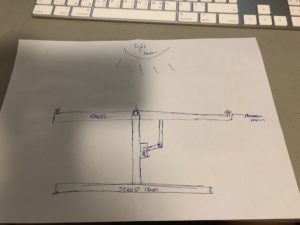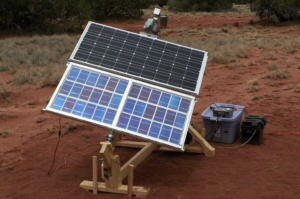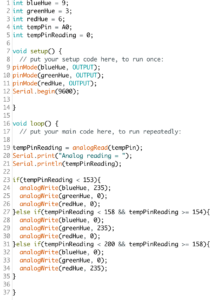While listening to Ross’s thunderous snore on our 7 hour flight to Amsterdam, I decided that I might as well start working on my IM project since sleeping was already out of the question.
My portrait begins with a black background that sort of resembles a dark room. Once you click the switch, the “lights” turn on and the actual portrait is revealed. I added some interactions to my portrait to make things a bit more interesting.
Here’s a video demonstrating how it works:
My code:
int clickedX;
int clickedY;
PImage img;
void setup(){
size(800, 800);
background(0, 0, 0);
img = loadImage(“switch.jpg”);
image(img, 300, 300, 200, 200);
}
void draw(){
if(clickedX > 300 && clickedX < 500 && clickedY > 300 && clickedY < 500){
background(255, 150, 150);
noStroke();
//face
fill(224, 172, 105);
rect(200, 150, 400, 500, 70);
//eyebrows
strokeWeight(20);
stroke(0, 0, 0);
line(250, 250, 290, 230);
line(290, 230, 380, 250);
line(420, 250, 510, 230);
line(510, 230, 550, 250);
//eyes
noStroke();
fill(255);
arc(320, 300, 100, 70, 0, 2*PI);
arc(480, 300, 100, 70, 0, 2*PI);
fill(25, 51, 0);
arc(322, 300, 60, 60, 0, 2*PI);
arc(482, 300, 60, 60, 0, 2*PI);
fill(0, 0, 0);
arc(322.5, 300, 40, 40, 0, 2*PI);
arc(482.5, 300, 40, 40, 0, 2*PI);
//sunglasses
if(mouseX > 250 && mouseX < 550 && mouseY > 250 && mouseY < 340){
noStroke();
fill(0, 0, 0);
rect(250, 255, 140, 100, 30);
rect(410, 255, 140, 100, 30);
rect(300, 280, 150, 20, 30);
rect(200, 280, 150, 20, 30);
rect(540, 280, 60, 20, 30);
}
//nose
strokeWeight(8);
stroke(25, 51, 0);
line(400, 350, 430, 450);
line(400, 450, 430, 450);
//mouth
strokeWeight(12);
stroke(139, 0, 0);
bezier(375, 550, 390, 555, 400, 560, 425, 560);
//ears
noStroke();
fill(224, 172, 105);
arc(200, 350, 80, 100, PI/2, 3*PI/2);
arc(600, 350, 80, 100, -PI/2, PI/2);
fill(25, 51, 0);
arc(200, 350, 40, 60, PI/2, 3*PI/2);
arc(600, 350, 40, 60, -PI/2, PI/2);
//hair
strokeWeight(8);
stroke(0, 0, 0);
bezier(210, 170, 213, 150, 217, 130, 240, 80);
bezier(240, 170, 243, 150, 247, 130, 270, 80);
bezier(270, 170, 273, 150, 277, 130, 300, 80);
bezier(300, 170, 303, 150, 307, 130, 330, 80);
bezier(330, 170, 333, 150, 337, 130, 360, 80);
bezier(360, 170, 363, 150, 367, 130, 390, 80);
bezier(390, 170, 393, 150, 397, 130, 420, 80);
bezier(420, 170, 423, 150, 427, 130, 450, 80);
bezier(450, 170, 453, 150, 457, 130, 480, 80);
bezier(480, 170, 483, 150, 487, 130, 510, 80);
bezier(510, 170, 513, 150, 517, 130, 540, 80);
bezier(540, 170, 543, 150, 547, 130, 570, 80);
bezier(570, 170, 573, 150, 577, 130, 600, 80);
//chin
strokeWeight(4);
stroke(25, 51, 0);
noFill();
bezier(360, 635, 375, 660, 385, 660, 400, 635);
bezier(400, 635, 415, 660, 425, 660, 440, 635);
}
//mustache
if(mouseX > 370 && mouseX < 430 && mouseY > 545 && mouseY < 565){
//noStroke();
//fill(0, 0, 0);
//rect(350, 500, 100, 20);
strokeWeight(10);
stroke(0, 0, 0);
noFill();
bezier(300, 480, 310, 505, 370, 508, 380, 510);
bezier(420, 510, 430, 508, 490, 505, 500, 480);
}
//ears
//noStroke();
//fill(224, 172, 105);
//arc(200, 350, 80, 100, PI/2, 3*PI/2);
//arc(600, 350, 80, 100, -PI/2, PI/2);
//fill(25, 51, 0);
//arc(200, 350, 40, 60, PI/2, 3*PI/2);
//arc(600, 350, 40, 60, -PI/2, PI/2);
//left airpod
if(mouseX > 120 && mouseX < 200 && mouseY > 350 && mouseY < 430){
noStroke();
fill(255, 255, 255);
rect(180, 340, 15, 70, 6);
rect(185, 340, 15, 20, 6);
rect(605, 340, 15, 70, 6);
rect(600, 340, 15, 20, 6);
}
//right airpod
if(mouseX > 600 && mouseX < 680 && mouseY > 350 && mouseY < 430){
noStroke();
fill(255, 255, 255);
rect(180, 340, 15, 70, 6);
rect(185, 340, 15, 20, 6);
rect(605, 340, 15, 70, 6);
rect(600, 340, 15, 20, 6);
}
//moving eyebrows left
if(mouseX > 250 && mouseX < 550 && mouseY > 230 && mouseY < 250){
strokeWeight(22);
stroke(224, 172, 105);
line(250, 250, 290, 230);
line(290, 230, 380, 250);
line(420, 250, 510, 230);
line(510, 230, 550, 250);
strokeWeight(20);
stroke(0, 0, 0);
line(250, 220, 290, 200);
line(290, 200, 380, 220);
line(420, 220, 510, 200);
line(510, 200, 550, 220);
}
}
void mouseClicked(){
clickedX = mouseX;
clickedY = mouseY;
}



